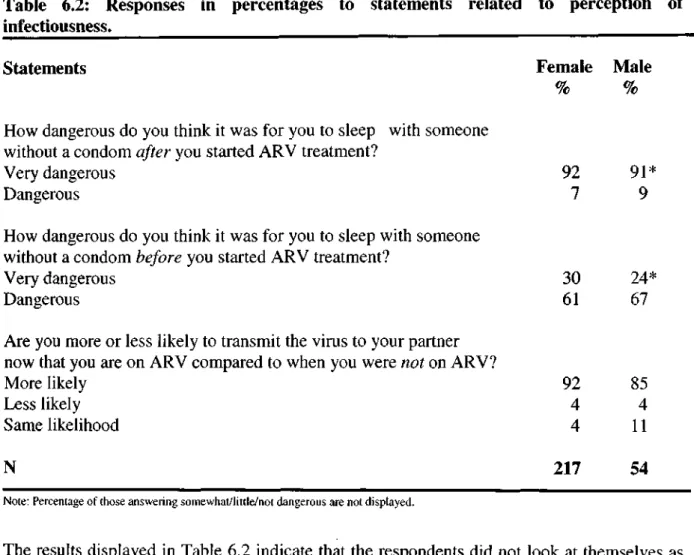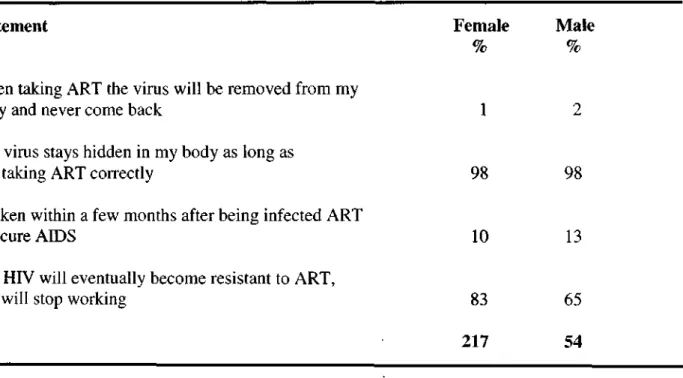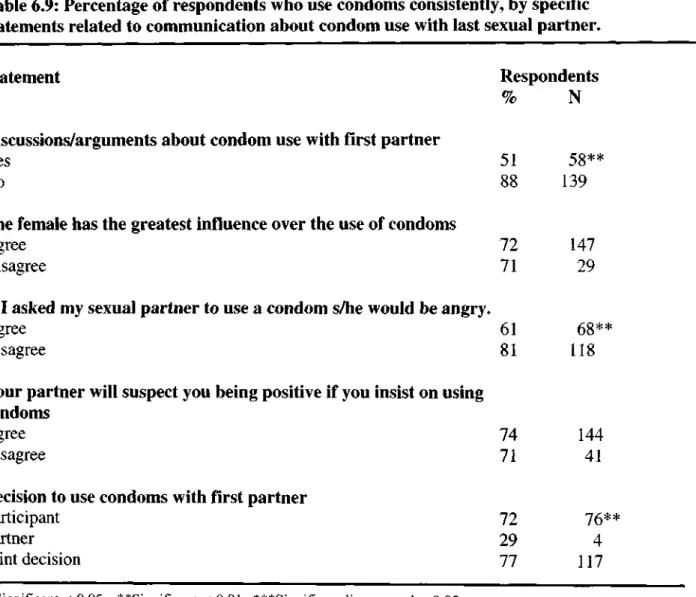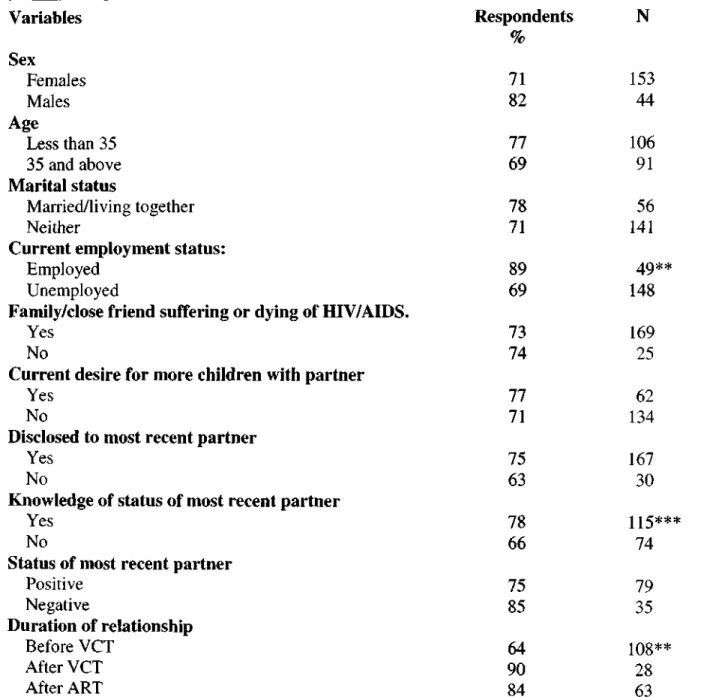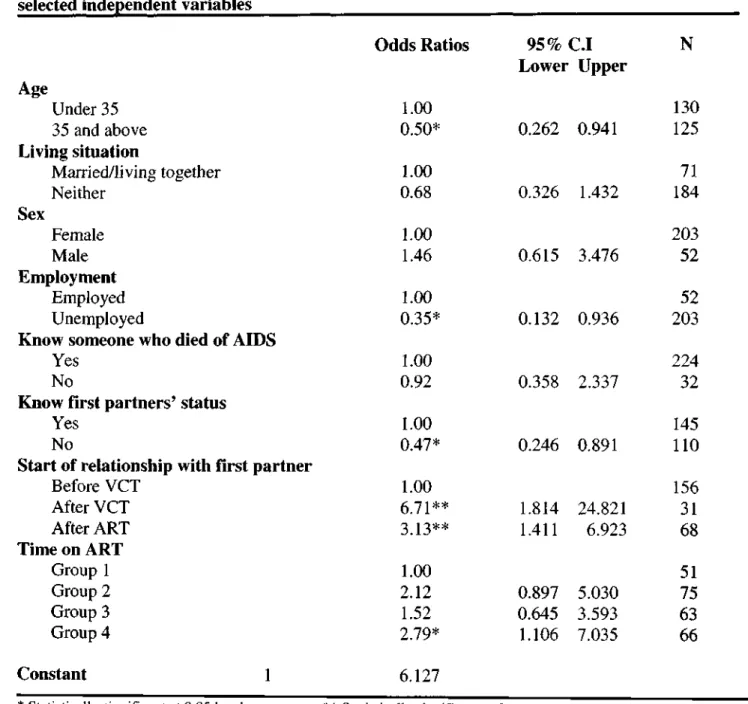The stage at which members of the sample population entered a relationship was also a predictor of condom use. Examining condom use is particularly important given that condom use is low in sub-Saharan Africa (Agha, Kusanthan, Longfield, Klein & Berman, 2002, Maharaj & Cleland, 2004, South African Department of Health, 2004).
Background to the Research .1 The Epidemiology of HIV/AIDS
Proportionately, South Africa bears the highest burden of people living with HIV/AIDS in the world (UNAIDS, 2006). In 2002, about 2.1 percent of the uninfected population in South Africa was infected with HIV (Dorrington et al, 2002).
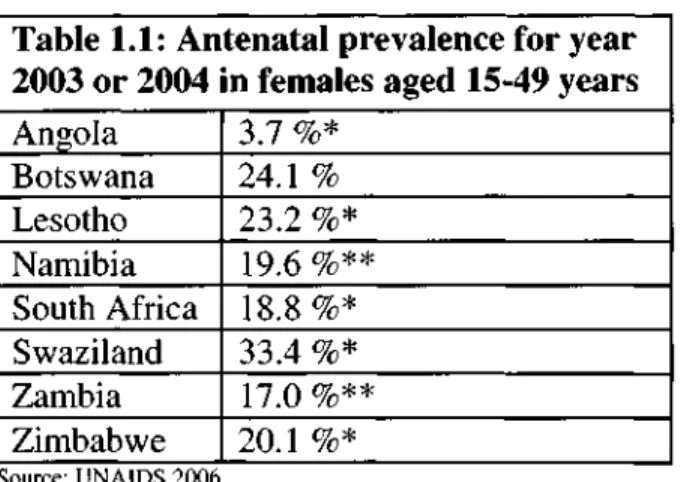
The Impact of the HIV/AIDS Epidemic in South Africa
Access to Antiretroviral Therapy .1 What is ART?
The number of people currently in treatment is tens of thousands less than the target set out in the government's operational plan (TAC, 2004). An estimated 13 805 additional public health posts are needed to implement the government's operational plan (South African Department of Health. 2003a).
Purpose of the Study
It is difficult to determine how great the risk of HIV transmission is in people taking ART in the absence of condom use. It is therefore important to investigate sexual behaviors and perceptions, attitudes and knowledge about ART and condom use among patients who have started ART in South Africa.
Objectives
In South Africa, one-third of women aged 15 to 49 years reported using a condom during their last intercourse (South African Department of Health, 2004). Incomplete adherence and low rates of condom use increase the likelihood of new infections, reinfections and drug resistance.
Organisation of the Research Report
LITERATURE REVIEW
- Introduction
- Adherence and the Role of Condoms
- What Factors Influence Adherence?
- Condom Use
- Condom Use and Disclosure after VCT
- Gender Roles and VCT
- ART and Risky Sexual Behaviour
- Summary
It is therefore important to look at the general barriers to condom use in South African society. VCT has been found to facilitate communication about condom use among couples in the United States (Allen, Seruflira, Gruber et al, 1993).
THEORETICAL FRAMEWORK
- Introduction
- Health Related Conceptual Frameworks
- Applicability of the Models to this Study
- Summary
This part of the model includes advice from others and the mass media (Fisher & Fisher, 2000). The stages of change theory emphasize the process rather than the individual predictors of behavior change.
METHODOLOGY
- Introduction
- Study Design
- Study Setting
- Methods of Data Collection
- Sampling
- Methods of Analysis
- Transferability, Generalizability and Reliability
- Ethical Considerations
- Limitations of the Study
- Summary
This study uses a combination of qualitative and quantitative methods to explore the objectives of the study. After further development of the guide and training of the researchers, 20 new semi-structured interviews were conducted. The purpose of the semi-structured interviews was to discover some basic categories and some of their characteristics.
The questions related to sexual behavior were asked at the end of the interview (Babbie & Mouton, 2001). The qualitative part of the study, consisting of semi-structured interviews, was completed first. In the quantitative part of the study, survey questionnaires were carried out using face-to-face interviews.
QUALITATIVE ANALYSIS
Introduction
Analysis of Data
When asked why they decided to disclose their status, participants explained that they wanted to use condoms with their partner(s). They felt that it would be difficult to use condoms consistently with their partners if they had not disclosed this. He claims that it is not important to use condoms as both his partners are HIV positive.
For most participants, these obstacles were related to their partners not wanting to use condoms. You must use a condom because if you don't use a condom, it means you are spreading the virus. Rather, the findings suggest that the participants found it more important to use condoms when they started ART.
Summary
QUANTITATIVE ANALYSIS
Introduction
Descriptive Analysis of Data
More than half of the respondents had two or more living children, while 17 percent had no children. However, one third of respondents thought it was very dangerous to sleep with someone without a condom before starting ART. Overall, 22 percent of men and 4 percent of women reported having more than one partner after starting ART.
More than 80 percent of respondents disclosed their status to their last sexual partner. More than half of respondents (58%) were also afraid that their partner would reveal their status to others. Almost 82 percent of respondents who disclosed their last sexual partner were still in a relationship with him.
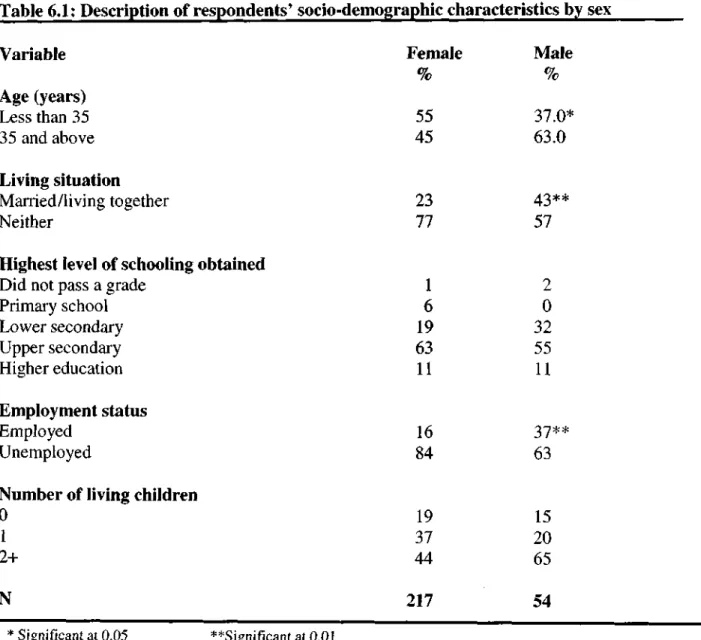
Factors Related to Condom Use - Bivariate Analysis
Consistent condom use is slightly lower with the second last person with whom the respondents had sex (68%). The chi-square test indicates that there is no significant difference in condom use with last partner and second last partner (df=2, P=0.819). This section will look at the relationship between condom use with last partner and a number of background characteristics.
This number is too low to test for significance, so the analysis will focus only on condom use by the last sexual partner. The last sexual partner condom use variable was recoded into a dichotomous variable, where 1 is someone who consistently used a condom and 0 is someone who did not. No significant association was found between condom use with the first partner and any of the statements described in Table 6.2 (see: page 62).
Factors Related to Condom Use - Multivariate Analysis
Multiple logistic regressions were performed as a way to control for all the other factors that were taken into account. All variables in table 6.10 were entered into the regression model except disclosure of last sexual partner and status of last partner. There were only 148 respondents who knew the status of their most recent partner, and it would therefore have created too many missing values if this variable had been included in the analysis.
The first category represents respondents who have been in RTSH for the shortest period of time.
Odds Ratios
- I Upper
- Summary
Those who did not know the status of their most recent partner were only half as likely to have used condoms consistently with that partner as those who knew their most recent partner status. Respondents who were employed were more likely to have used condoms consistently with their last sexual partner than those who were unemployed. People over 35 were only half as likely to have used a condom consistently with their last sexual partner compared to those under 35.
The odds ratios show that respondents who have been on ART for the longest time (group 4) were 2.79 times more likely to have used condoms consistently than the respondents who have been on ART for the shortest time (group 1). It is possible that the decline in condom use will occur at a later date. Many of the variables related to communication between respondents and their partners were associated with condom use.
DISCUSSION AND CONCLUSION
- Discussion
- Key Findings and Recommendations
There are 27 percent of respondents who do not use condoms consistently, and there are major obstacles to condom use. These findings suggest that the nature of communication between partners is strongly associated with condom use. Both qualitative and quantitative research shows that some respondents had problems with condoms themselves, which could lead to negative attitudes towards condom use.
This study found that consistent condom use increases with an increase in respondents' time on ART (df=270, P=0.021). The level of condom use is higher than that found in the general population (Shisana et al, 2005; South African Department of Health, 2004). The sample population was found to face many of the same challenges as people who do not know their status when negotiating condom use.
Men and ARVs: How does being a man affect access to antiretroviral therapy in South Africa? 'CSSR Working Paper No. Changes in sexual behavior and risk of HIV transmission following antiretroviral therapy and prevention interventions in rural Uganda'. The value of patient-reported adherence to antiretroviral therapy in predicting virologic and immunologic response'.
Men's attitudes towards family planning in the era of HIV/AIDS: Evidence from KwaZulu-Natal, South Africa'. Consistency of adherence to antiretroviral therapy predicts biological outcomes for human immunodeficiency virus-infected persons in clinical trials. Relationship of unsafe sexual behavior and sexual partner characteristics of HIV-infected and HIV-uninfected adolescent females.
GUIDE FOR IN-DEPTH INTERVIEWS WITH PATIENTS ON ANTIRETROVIRAL THERAPY
- Have you heard of ART?
- How did you hear about Ithembalabantu?
- What do you know about ART?
- What are some of the advantages of being on ART?
- What type of drugs are you currently taking and how often do you take them?
- How sick were you before you started ART?
- How does the antiretroviral drugs make you feel?
- How do you find the providers at Ithembalabantu?
- How did you find out about your HIV-status?
- Do you think having to take tablets influence disclosure of HIV/AIDS?
- For those who did disclose only after they started ART: Why did you choose to disclose after you commenced ART?
- Before you found out you were HIV-positive, did you use any form of contraception?
- After you found out you were HIV-positive, did you use any form of contraception?
- Have you ever used condoms?
- Have you been treated for STIs after you found out you were HIV-positive?
- How many sexual partners have you had since you found out you were HIV- positive?
- How likely do you think you are to transmit the virus to your partner when you are on ART?
- What happened to your last partner?
- Why have you not had any sexual partners after commencing ART?
- What happened to your former partner?
If so, how long after you found out you were HIV positive did you tell him/her? Do you think your partner would leave you if you told him/her about your status? For those who only disclosed after starting ART: Why did you choose to disclose after starting ART. to state after you started ART.
Before you found out you had HIV, were you using any form of birth control? Did you use any contraception after you found out you were HIV positive? How many sexual partners have you had since you found out you are HIV positive?
Antiretroviral Treatment and High Risk Sexual Behavior
- DEMOGRAPHIC INFORMATU QID
- KNOWLEDGE OF VIRAL LOAD AND CD4 COUNT
- KNOWLEDGE ABOUT ARV TREA1 Now I am going to ask you questions concerning yo
- PERCEPTION OF RISK OF TRANSMISSION
- PERCEPTIONS AND ATTITUDES TO ANTIRETROVIRAL TREATMENT How strongly do you agree or disagree with the following statements?
- SIDE EFFECTS AND QUALITY OF LIFE How sick were you before you
- ATTITUDES TO CONDOM USE AMONG PATIENTS ON ARV TREATMENT To help prevent the spread of AIDS, we need to know more about all the different types of sexual
- SEXUAL INTERCOURSE AND SEXUAL PARTNERS
- CHILDREN 63a
- DISCLOSURE AFTER STARTING ARV TREATMENT QID
- beginning
- At the same time
- At the same
- SEXUAL BEHAVIOR AND DISCLOSURE AFTER VCT
Strongly Agree 01 Agree 02 Neither Agree or Disagree 03 Disagree 04 Strongly Disagree 05 Don't Know 99 Strongly Agree 01 Agree 02 Neither Agree or Disagree 03 Disagree 04 Strongly Disagree 05 Don't Know 99/ 01 agree. or disagree 03 Disagree 04 Strongly disagree 05 Refuse 97 Strongly agree 01 Agree 02 Neither agree nor disagree 03 Disagree 04 Strongly disagree 05 Reject 97 Strongly agree 01. Strongly agree 02 Agree00 Disagree 05 Refused 97 Strongly Agree 01 Agree 02 Neither Agree or Disagree 03 Disagree 04 Strongly Disagree 05 Rejected 97.
Strongly Agree 01 Agree 02 Neither Agree or Disagree 03 Disagree 04 Strongly Disagree 05 Refuse 97 Strongly Agree 01 Agree 02 Neither Agree or Disagree 03 Disagree 04 Strongly Disagree 05 Strongly Reject02 or 970 Disagree 04 Strongly Disagree 05 Refused 97 Strongly Agree 01 Agree 02 Neither Agree or Disagree 03 Disagree 04 Strongly Disagree 05 Refuse 97 Strongly Agree 01 Agree 02 Neither Agree or Disagree 03 Disagree 04 Strongly Disagree 0701 Strongly Disagree or Strongly Disagree 03 Disagree 04 Strongly Disagree 05 Refused 97. Very Dissatisfied 01 Dissatisfied 02 Neither Dissatisfied or Dissatisfied 03 Satisfied 04 Very Satisfied 05 Don't Know 99 Not Applicable 94 Strongly Agree 01 Agree 02 Neither Agree or Disagree040 Strongly Agree 01 Agree 02 Neither Agree or Disagree 03 Disagree 04 Strongly Disagree 05 Disagree 97 Strongly Agree 01 Agree 02 Neither Agree or Disagree 03 Disagree 04 Strongly Disagree 05 Refuse 97 Strongly Agree 01 Agree 02 Disagree04 or Strongly Disagree03 97.
